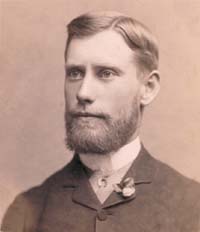History
The members, who all worked at Mount Gipps sheep station, which encompassed the Broken Hill, were:-
- Charles Rasp (1846–1907) – a boundary rider, who was interested in prospecting, recognised that the site was highly mineralized (though suspecting black tin oxide — perhaps cassiterite) and on 5 September 1883 persuaded David James and his offsider James Poole to help him peg out 40 acres (16 ha) and registered their claim with mining warden Richard O'Connell. [1]
- David James (1854–1926) – a contractor employed to sink dams and mend fences.
- James Poole (1848–1924) – worked with David James
- George McCulloch (1848–1907) – manager of Mount Gipps station, recommended widening the syndicate in order to control the greater part of the hill, proposed seven shares at £70 (several thousand dollars in today's money) each.
- Philip Charley (1863–1937) – a young man learning to be a sheep farmer, employed as a boundary rider.
- George Urquhart (1845–1915) – a bookkeeper and overseer
- George A. M. Lind (1861–1941) – a storekeeper.

In September 1883 they pegged seven 40-acre (160,000 m2) blocks (blocks No 10–16) along the exposed lode at Broken Hill, thus securing almost the whole of the easily worked ore (Curtis, 1908).
The initial assay results were not encouraging and Lind sold his share to Rasp and McCulloch, probably intimidated by the prospect of calls to finance further drilling. Poole and Urquhart sold their shares a year later, before the boom days and flotation of Broken Hill Proprietary in 1885 (Curtis, 1908 and Camilleri, 2006). James sold half his share to Sidney Kidman [ citation needed ] [a] who went on to become a wealthy cattle baron and landowner.